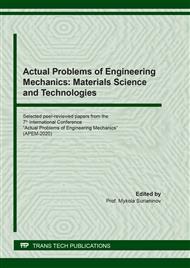p.27
p.35
p.43
p.53
p.59
p.66
p.73
p.80
p.93
Modeling and Optimization of Technology and Physics-Mechanical Properties of Composite Materials
Abstract:
To this day, there is a large volume collected of the results of experimental studies on structure changes in various dispersions serving as base for production of most construction materials. The analysis of collected information revealed that there is an entire category of stick-slip phenomena, the case history of which is represented by N-and S-type inflections on rheological, kinetic and other curves. We should emphasis that the view of such non-trivial charts is alike with geometry of standard curves of standard conditions. And this alikeness predetermines the possibility of applying topological models of «fold» and «ruffle» types for studying various abnormal effects. We must also note that besides N- and S-types there is a range of other characteristics («flags») pointing to applicability of the methods of catastrophe theory to studying certain processes initiating the apparition of interruptions in system development. Recognition of above-mentioned particularities allows determining the fact and type of catastrophe, the standardised structure of which facilitates finding strict patterns and thus defines directions of optimisation of various situations of research and practical nature. This work shows that pieces of evidence and consistent patters are reliably interpreted within the framework of the proposed concept.
Info:
Periodical:
Pages:
59-65
Citation:
Online since:
September 2020
Authors:
Price:
Сopyright:
© 2020 Trans Tech Publications Ltd. All Rights Reserved
Share:
Citation:


